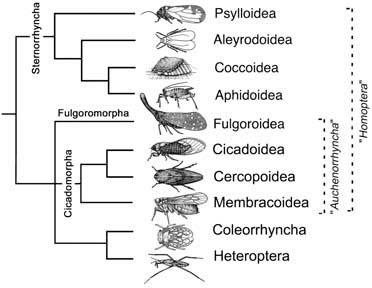1.4. Naming and classification of insects
The formal naming of insects follows the rules of nomenclature developed for all animals (plants have a slightly different system). Formal scientific names are required for unambiguous communication between all scientists, no matter what their native language. Vernacular (common) names do not fulfill this need: the same insects even may have different vernacular names amongst peoples that speak the same language. For instance, the British refer to “ladybirds”, whereas the same coccinellid beetles are “ladybugs” to many people in the USA. Many insects have no vernacular name, or one common name is given to many species as if only one is involved. These difficulties are addressed by the Linnaean system, which provides every described species with two given names (a binomen). The first is the generic (genus) name, used for a usually broader grouping than the second name, which is the specific (species) name. These latinized names are always used together and are italicized, as in this book. The combination of generic and specific names provides each organism with a unique name. Thus, the name Aedes aegypti is recognized by any medical entomologist, anywhere, whatever the local name (and there are many) for this disease-transmitting mosquito. Ideally, all taxa should have such a latinized binomen, but in practice some alternatives may be used prior to naming formally (section 17.3.2).
In scientific publications, the species name often is followed by the name of the original describer of the species and perhaps the year in which the name first was published legally. In this textbook, we do not follow this practice but, in discussion of particular insects, we give the order and family names to which the species belongs. In publications, after the first citation of the combination of generic and species names in the text, it is common practice in subsequent citations to abbreviate the genus to the initial letter only (e.g. A. aegypti). However, where this might be ambiguous, such as for the two mosquito genera Aedes and Anopheles, the initial two letters Ae. and An. are used, as in Chapter 15.
Various taxonomically defined groups, also called taxa (singular taxon), are recognized amongst the insects. As for all other organisms, the basic biological taxon, lying above the individual and population, is the species, which is both the fundamental nomenclatural unit in taxonomy and, arguably, a unit of evolution. Multi-species studies allow recognition of genera, which are discrete higher groups. In a similar manner, genera can be grouped into tribes, tribes into subfamilies, and subfamilies into families. The families of insects are placed in relatively large but easily recognized groups called orders. This hierarchy of ranks (or categories) thus extends from the species level through a series of “higher” levels of greater and greater inclusivity until all true insects are included in one class, the Insecta. There are standard suffixes for certain ranks in the taxonomic hierarchy, so that the rank of some group names can be recognized by inspection of the ending (Table 1.1).
Depending on the classification system used, some 30 orders of Insecta are recognized. Differences arise principally because there are no fixed rules for deciding the taxonomic ranks referred to above — only general agreement that groups should be monophyletic, comprising all the descendants of a common ancestor (Chapter 7). Orders have been recognized rather arbitrarily in the past two centuries, and the most that can be said is that presently constituted orders contain similar insects differentiated from other insect groups. Over time, a relatively stable classification system has developed but differences of opinion remain as to the boundaries around groups, with “splitters” recognizing a greater number of groups and “lumpers” favoring broader categories. For example, some North American taxonomists group (“lump”) the alderflies, dobsonflies, snakeflies, and lacewings into one order, the Neuroptera, whereas others, including ourselves, “split” the group and recognize three separate (but clearly closely related) orders, Megaloptera, Raphidioptera, and a more narrowly defined Neuroptera (Fig. 7.2). The order Hemiptera sometimes was divided into two orders, Homoptera and Heteroptera, but the homopteran grouping is invalid (non-monophyletic) and we advocate a different classification for these bugs shown stylized on our cover and in detail in Fig. 7.5 and Box 11.8.
In this book we recognize 30 orders for which the physical characteristics and biologies of their constituent taxa are described, and their relationships considered (Chapter 7). Amongst these orders, we distinguish “major” orders, based upon the numbers of species being much higher in Coleoptera, Diptera, Lepidoptera, Hymenoptera, and Hemiptera than in the remaining “minor” orders. Minor orders often have quite homogeneous ecologies which can be summarized conveniently in single descriptive/ecological boxes following the appropriate ecologically based chapter (Chapters 9–15). The major orders are summarized ecologically less readily and information may appear in two chapters. A summary of the diagnostic features of all 30 orders and cross references to fuller identificatory and ecological information appears in tabular form in the Appendix.
Table 1.1. Taxonomic categories (obligatory categories are shown in bold).
| Taxon category | Standard suffix | Example |
|---|---|---|
| Order | Hymenoptera | |
| Suborder | Apocrita | |
| Superfamily | -oidea | Apoidea |
| Family | -idae | Apidae |
| Subfamily | -inae | Apinae |
| Tribe | -ini | Apini |
| Genus | Apis | |
| Subgenus | ||
| Species | A. mellifera | |
| Subspecies | A. m. mellifera |

Broken lines indicate uncertain relationships. Thysanura sensu lato refers to Thysanura in the broad sense. (Data from several sources)

Broken lines indicate paraphyletic taxa, with names italicized. (After Bourgoin & Campbell 2002)

